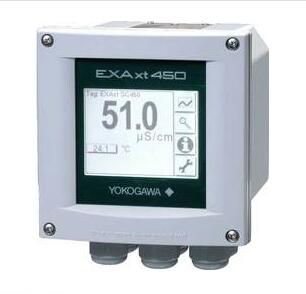Universal Contacting Conductivity Analyzers
One way to make a conductivity measurement is called contacting conductivity. In this type of measurement the sensing elements come in contact with the process so the sensors are called contacting electrodes. The conductivity is measured by applying an alternating electrical current to the sensor electrodes (that together make up the cell constant) immersed in a solution and measuring the resulting voltage. The solution acts as the electrical conductor between the sensor electrodes.
| Model Code | FLXA21 | FLXA202 | SC450G |
|---|---|---|---|
| Area Classification |
|
|
|
| Enclosure Material | Plastic (Polycarbonate) | Aluminum alloy die cast with epoxy coating (Standard offering Aluminum alloy die cast with urethane or high anti corrosion coating (available upon request) | Cast Aluminum with chemically resistance coating; polycarbonate cover with polycarbonate flexible window |
| Housing Rating | IP66/ NEMA 4A/ CSA 3S | IP66 (except Canada), Type 4X (except Canada), Type 3S/4X (Canada) | IP66/ NEMA 4A/ CSA 3S |
| Power Supply | 2-wire 24VDC, Loop Powered | 2-wire 24VDC, Loop Powered | 4-Wire 110-256 VAC, Mains Power |
| Output Signal | Bi-directional HART digital communication, superimposed on mA (4-20mA) signal. | Bi-directional HART digital communication, superimposed on mA (4-20mA) signal. | Two isolated outputs of 4 to 20 mA DC with common negative. |
The model FLEXA® two-wire analyzer is used for continuous on-line measurements in industrial installations. It offers an option for single or dual sensor measurement, making it the most flexible 2-wire analyzer available. The model FLEXA® modular-designed series analyzer.
One analyzer can accept any of 4 types of measurements; pH/ORP, Contacting Conductivity (SC), Inductive Conductivity (ISC) and Dissolved Oxygen (DO)
Dual sensor measurement on a 2-wire type analyzer pH/ORP and pH/ORP, SC and SC, and DO and DO
Modular design: replaceable sensor modules
Redundant system on dual sensor measurement
Variety of materials of construction: SS or Plastic
Intuitive easy touch screen operation on 2-wire type analyzer
Unique HMI menu structure in 12 languages
Quick setup menu for fast and east measurement operation
Online Sensor Wellness checking for predictive maintenance
NEMA 4X / IP66 Enclosure
| Input specification | Two or four electrode measurement with square wave excitation, using max. 60 m cable and cell constants from 0.005 to 50.0 cm-1 |
|---|---|
| Detection method | Frequency, read-pulse position and reference voltage are dynamically optimized. |
| Input ranges | Conductivity: 0.000 μS/cm to 2000 mS/cm Minimum: 1 μS/cm (underrange 0.000 μSx C). Maximum: 200 mS/cm (overrange 2000 mS x C). Resistivity: 0.0 Ω x cm to 1000 MΩ x cm Minimum: 5 Ω x cm (underrange 0 Ω/C). Maximum: 1 MΩ x cm (overrange 1000 MΩ/C). Temperature: Pt1000: -20 to 250°C (0 to 500°F) Pt100 and Ni100: -20 to 200°C (0 to 400°F) NTC 8k55: -10 to 120°C (10 to 250°F) Pb36 NTC: -20 to 120°C (0 to 250°F) |
| Conductivity/Resitivity Accuracy | ≤0.5 % of reading |
| Temperature Accuracy | ≤0.3°C (≤ 0.4°C for PT100) |
| Step Response | ≤4 sec for 90 % (for a 2 decade step) |
| Transmission Signals | Two isolated outputs of 4 to 20 mA DC with common negative. Maximum load 600 Ω. Bi-directional HART digital communication, superimposed on mA 1 (4 to 20 mA) signal. Burn up (21.0 mA) or Burn down (3.6 mA) to signal failure accorded with NAMUR NE43. |
| Temperature compensation | Automatic or manual, for temperature ranges. Reference temp.: programmable from 0 to 100°C or 30 to 210°F (default 25°C). |
| Compensation algorithm | According IEC 60746-3 NaCl tables (default). Two independent user programmable temperature coefficients, from 0 to 3.5 %/°C (°F) by adjustment or calibration. Matrix compensation: with conductivity function of concentration and temperature. Choice out of 13 preprogrammed matrixes. |
| Display | Graphical Quarter VGA (320 x 240 pixels) LCD with LED backlight and touchscreen. |
| Contact Outputs | Four SPDT relay contacts with display indicators. Contact outputs configurable for hysteresis and delay time. |
| Contact Input | Remote range switching to 10 times the programmed range. |
| Power Supply | 85 to 265 V AC ±10 %, 47 to 63 Hz, maximum consumption 10 VA. 9.16 to 30 V DC ±15 %, maximum consumption 10 W. |



